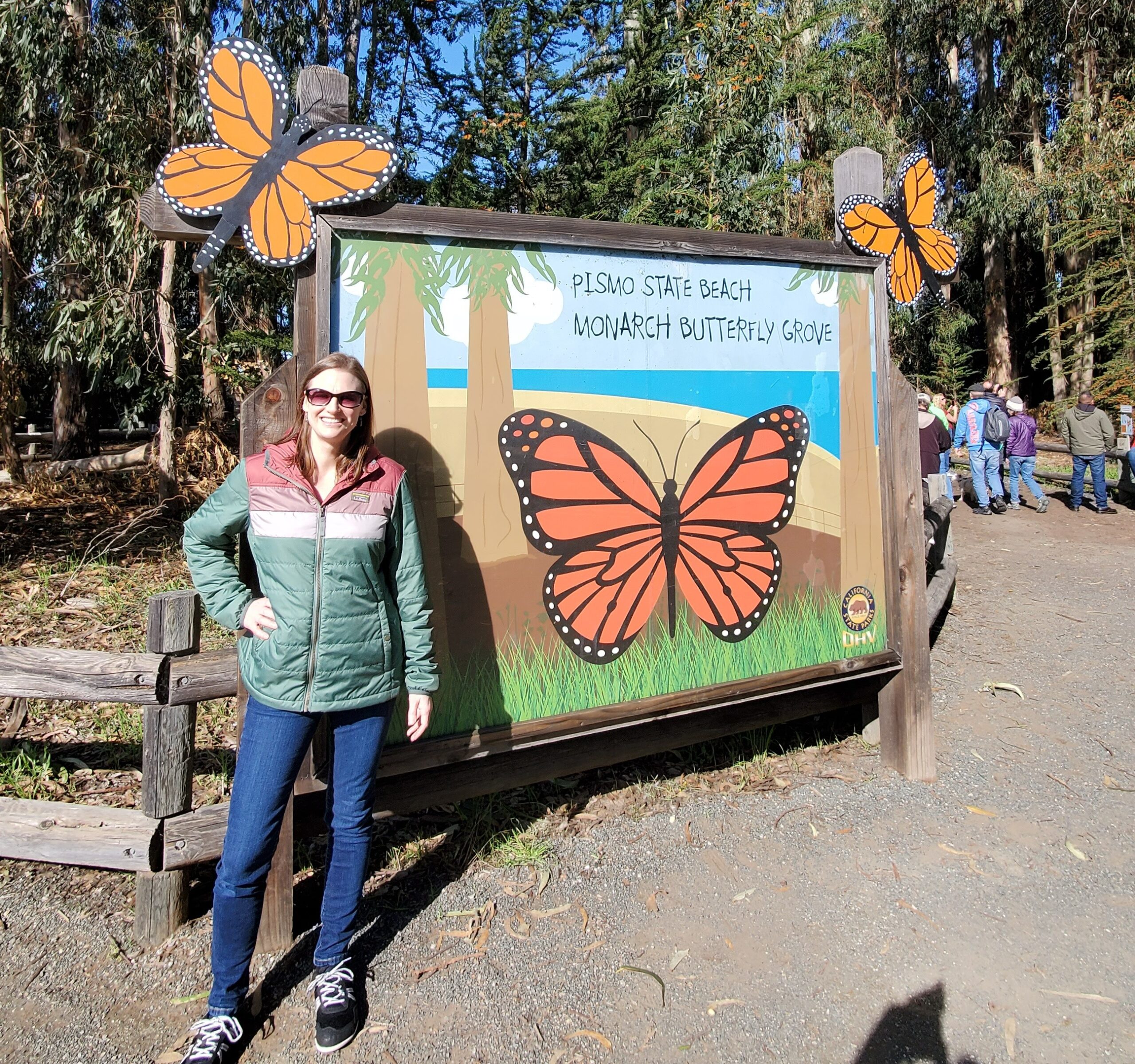We have much more to do and your continued support is needed now more than ever.
Treasure at Pismo Beach

Amidst recent storm damage, hope displays its colors.
As Morgan Parks, National Wildlife Federation’s Oregon education manager, walked along the trails of an old eucalyptus grove at Pismo Beach, California, she could see evidence of recent severe storms: Giant, exposed tree roots, debris littering the ground within the groves, and sagging, broken branches. But she spotted something else amid the destruction when she looked closely enough at the undamaged tree limbs:
Butterflies, thousands of butterflies.

In January, Morgan attended the second International Western Monarch Summit in San Luis Obispo, California, hosted by Western Monarch Advocates (WMA) and attended by many western monarch conservation organizations, researchers, community scientists, and western state agencies’ staff. WMA’s mission is “To serve as an overarching entity to encourage and facilitate communication and interaction of groups and individuals committed to restoring the western monarch butterfly population – regardless of their affiliation or location…” As part of the Summit, Morgan and other attendees went on a few field trips to Pismo State Beach Monarch Butterfly Grove, where many of the western monarch butterflies come in the fall to overwinter for several months.

“My first visit to an overwintering site was in January 2020. That was the year when the western monarch population crashed to less than 2,000 butterflies. From seeing only a couple dozen butterflies that year at Pacific Grove to over 10,000 at Pismo Beach in 2023, it was such a juxtaposition.”
MORGAN PARKS
It was a welcome contrast, this time, to see so many more monarchs – five times more! – especially in an area recently stormed by effects of climate change.
“Seeing the winter storm damage – huge eucalyptus trees uprooted and toppled over – habitat that can never be replaced fast enough, really highlights how important these overwintering sites are to monarchs and how vulnerable they are to extreme weather events,” Morgan says, explaining that the area’s old eucalyptus and Monterey cypress trees are the monarch’s preferred roosting sites. Those trees are what draw them to this spot. Skirting the storm damage one afternoon, Morgan observed clusters of monarchs, blending in so well that if you didn’t know what you were looking at you would think they were just more trembling, dried leaves hanging from the branches.


Monarchs at Their Best
Monarchs are known for their vivid orange wings and signature black lines and white markings. But this striking display of color is only found on the inside, revealed as the monarchs dance through the air or perch with unfolded wings. When roosting at night or in cold temperatures, the wings close, the brilliant amber color dulled to a tan shade that provides excellent camouflage.
As the day warms up, however, the monarchs start to flaunt their colors. Accompanied by U.S. Fish and Wildlife Service staff as well as chair of the Western Association of Fish and Wildlife Associations’ (WAFWA) Western Monarch & Native Insect Pollinator Working Group, Morgan visited the grove once again, to see the monarchs at their best. Despite the wreckage all around, with the sun directly overhead the eucalyptus grove was brought to life. Butterflies stretched their wings, illuminating the trees and painting the air, “flitting and fluttering, their wings vibrant orange against a bright blue sky,” Morgan describes. “It was truly magical, something I wish more people had the opportunity to experience.” You had to watch where you walk, though, she added, to make sure you didn’t step on any taking a break from their flashy display.
Mating of the overwintering generation of monarchs occurs once temperatures rise, which is typically around late February and into March. Once monarchs start mating in the overwintering sites, it is a sign that they will start their spring migration. Monarchs then leave their overwintering sites in search of more nectar plants and early emerging native milkweed plants to lay their eggs on.
During the 26th annual Western Monarch Thanksgiving Count put on by the Xerces Society last November, volunteers counted 335,479 monarch butterflies, an increase from the previous year’s total of 247,237. In the wake of the winter storms, Xerces’ New Year’s count found a 58% seasonal decrease in monarch numbers for that time between Thanksgiving and New Year’s.

What’s next for these vulnerable butterflies?
This spring, partners are coming together to discuss and make plans for supporting the western monarch population’s recovery, and during the fiscal year of 2024, the U.S. Fish and Wildlife Service is due to issue a proposed rule to list and protect the monarch under the Endangered Species Act, if the monarch is still warranted after its annual status assessment.
In the meantime, we can all do something to help the western migratory monarch reach the 5-year average population size recommended by WAFWA of 500,000 as an initial goal for recovery. WAFWA has created several fact sheets outlining how individuals can become “monarch scientists,” including by participating in monarch butterfly counts. You can also be a monarch champion in supporting their habitat by planting native milkweed to provide the monarchs with needed nectar and by avoiding the use of insecticides. Or by learning about the species and their migration habits, the organized efforts to bolster their numbers, and the threats facing them.

With the Mayors’ Monarch Pledge open until April 30, this is also a great opportunity for heads of local and tribal governments to join in leading conservation efforts for monarchs in their own communities!
As National Wildlife Federation’s chief monarch recovery strategist Dr. Rebeca Quiñonez-Piñón said in a recent press release: “We don’t want to count on luck alone to ensure the survival of the western monarch migration.” If we are to fulfill Morgan’s wish for present and future generations to marvel over these vivacious but vulnerable monarchs, all efforts are needed.





















